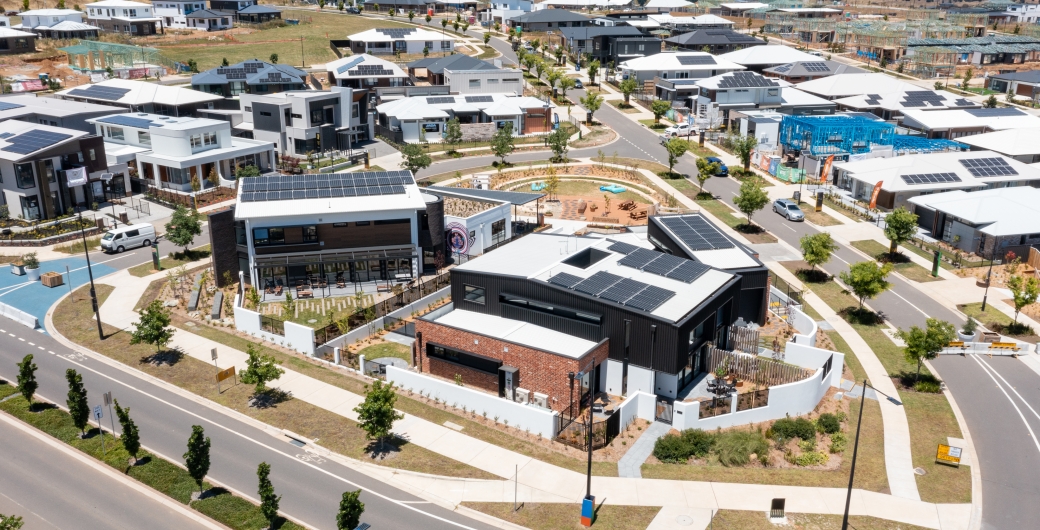
Roof colours vary in the new suburb of Whitlam where energy rebates are having an impact. Photo: Suburban Land Agency.
Is the ACT Government going to ban black roofs in new residential areas?
It’s not saying, but it does want to know what the benefits of cool, or lighter coloured, roofs that reflect heat are and how much it would cost to mandate them.
The Environment, Planning and Sustainable Development Directorate has contracted UNSW to conduct a study into cool roofs as a first step towards potential requirements for new homes in the ACT.
Black or dark coloured roofs dominate the urban landscape in Australia despite their known contribution to the heat island effect.
A NSW Government bid in 2022 to ban black roofs faltered after a pushback from property developers complaining about the greater regulatory burden and cost.
A directorate spokesperson said the study would look at what reductions in urban heat could be achieved with cool roofs, and the energy savings and costs for homeowners.
It would also assess any additional building costs that may be incurred or savings to be gained.
“Light-coloured materials themselves don’t typically have a higher cost,” the spokesperson said. “However, roof colour feeds into achieving a home energy rating for new homes. This is because cool roofs are beneficial for keeping a home cool in summer, but could potentially increase winter energy needs.”
The spokesperson said new suburbs could be much hotter than established ones, particularly while street trees and gardens were still growing.
“This can add to residents’ cooling costs, have health impacts for vulnerable people and make outdoor activities unpleasant in hot weather,” the spokesperson said.
According to the contract, UNSW must consider likely heating and cooling requirements under current and future climate scenarios, in both air-conditioned and non-air-conditioned homes, as well as the impact of urban heat in residential zones under a “do nothing” scenario and a scenario where cool roof provisions are put in place.
It has been tasked to develop cool roof rules that could be implemented through the planning or building system, and recommend the most effective pathway for implementing them.
The contract says UNSW should look at what barriers there may be to introducing requirements including physical disadvantages and cost, what exemptions there should be and what other ways could be used to reduce urban heat.
EPSDD said light-coloured roofing steel and tiles were readily available and high-tech options like green roofs and dark-looking materials that reflected heat were also available, though not widely used on homes yet.
“The study is unlikely to recommend mandating high-tech options,” the spokesperson said.
The Suburban Land Agency (SLA) offered energy rebates in new suburbs, including in Whitlam and Jacka, which provided homeowners with a financial carrot for meeting energy requirements, including for a cool roof.
This had had an excellent take-up in Whitlam where about 30 per cent of roofs were ‘cool’.
The spokesperson said the new planning system also included an urban heat assessment outcome for commercial zones and the Community Facility Zone that encouraged use of cool roofs for offices, schools and mixed-use apartment buildings.
Master Builders ACT CEO Michael Hopkins said black roofs and black external materials impacted a building’s energy efficiency rating.
“The National Construction Code has recently increased the minimum energy rating to 7 stars, meaning black roofs are already considered when new buildings are being designed,” he said.
“The ACT Government has been working with industry on the implementation of the NCC, and we will continue to work with government on how we create more energy efficient buildings.”
A spokesperson for Sustainable Building and Construction Minister Rebecca Vassarotti said the government regularly investigated emerging technologies to understand their potential impact on its continuing work to mitigate the heat impact of climate change in the suburbs.
“The government is undertaking an exciting first step of investigation into cool roofs – to help us understand if cool roof requirements for residential areas would be beneficial,” the spokesperson said.
“The outcome of the study will determine if broader industry and community consultation is needed in future.”
The government spokesperson said the government was actively considering consultation with the building industry so that this initial investigation could incorporate its technical expertise and information.
UNSW is expected to deliver a final report in June.
The contract is worth almost $106,000.
Original Article published by Ian Bushnell on Riotact.


